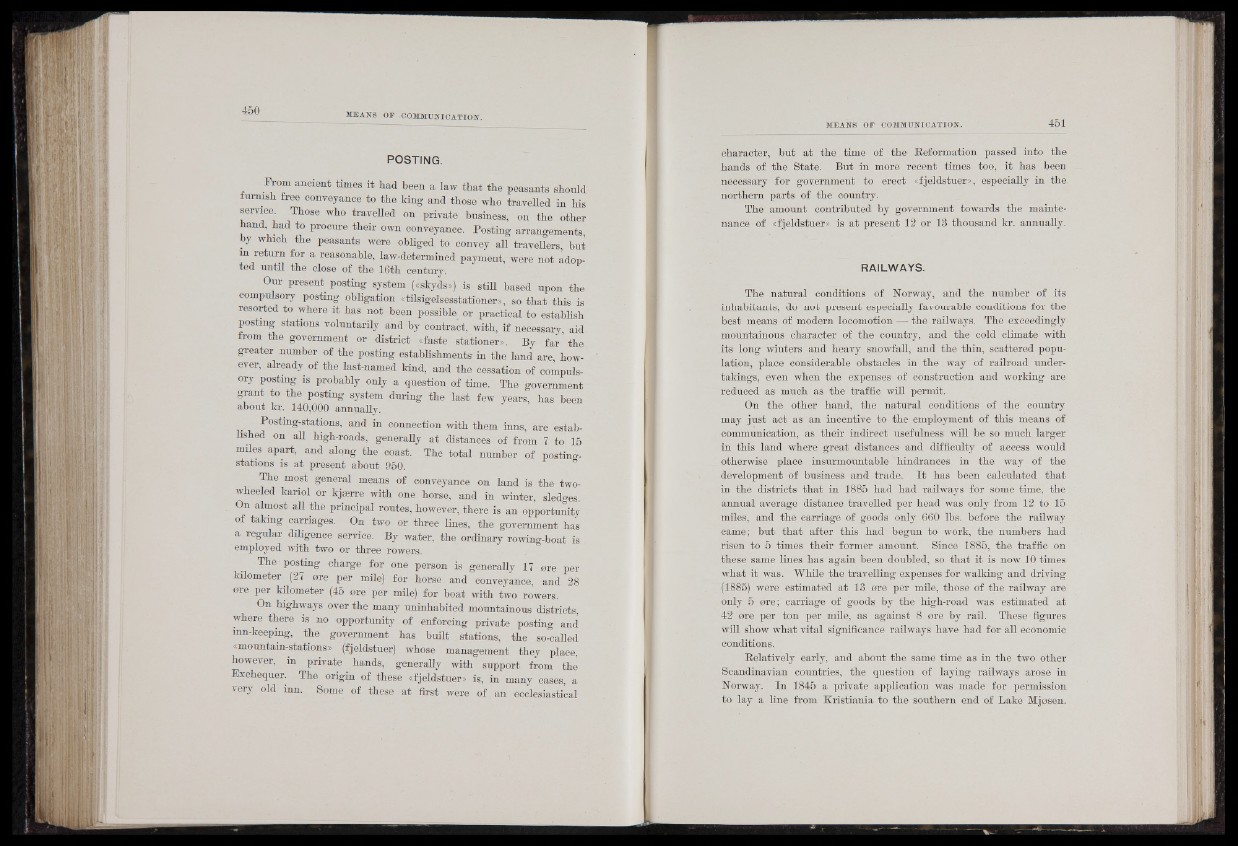
POSTING.
Erom ancient times it had been a law that the peasants should
furnish free conveyance to the king and those who travelled in his
service^ Those who travelled on private business, on the other
and had to procure their own conveyance. Posting arrangements,
by which the peasants were obliged to convey all travellers, but
m return for a reasonable, law-determined payment, were not adopted
until the close of the 16th century.
Our present posting system («skyds») is still based upon the
compulsory posting obligation «tilsigelsesstationer», so that this is
resorted to where it has not been possible or practical to establish
posting stations voluntarily and by contract, with, if necessary aid
from the government or district «faste stationer». By fa r’ the
greater number of the posting establishments in the land are, however,
already of the last-named kind, and the cessation of compulsory
posting is probably only a question of time. The government
grant to the posting system during the last few years, has been
about kr. 140,000 annually.
Posting-stations, and in connection with them inns, are established
on aU high-roads, generally at distances of from 7 to 15
miies apart, and alqng the coast. The total number of posting-
stations is at present about 950.
The most general means of conveyance on land is the twowheeled
kariol or kjserre with one horse, and in winter, sledges.
On almost all the principal routes, however, there is an opportunity
of taking carnages. On two or three lines, the government has
a regular diligence service. By water, the ordinary rowing-boat is
employed with two or three rowers.
The posting charge for one person is generally 17 ore per
kilometer (27 ore per mile) for horse and conveyance, and 28
ore per kilometer (45 ore per mile) for boat with two rowers.
On highways over the many uninhabited mountainous districts,
where there is no opportunity of enforcing private posting and
inn-keeping, the government has built stations, the so-called
«mountain-stations» (fjeldstuer) whose management they place,
however, in private hands, generally with support from the
Exchequer. The origin of these «fjeldstuer» is, in many cases, a
very old inn. Some of these at first were of an ecclesiastical
character, but at the time of the Beformation passed into the
hands of the State. But in more recent times too, it has been
necessary for government to erect «fjeldstuer», especially in the
northern parts of the country.
The amount contributed by government towards the maintenance
of «fjeldstuer» is at present 12 or 13 thousand kr. annually.
RAILWAYS.
The natural conditions of Norway, and the number of its
inhabitants, do not present especially favourable conditions for the
best means of modern locomotion S the railways. The exceedingly
mountainous character of the country, and the cold climate with
its long winters and heavy snowfall, and the thin, scattered population,
place considerable obstacles in the way of railroad undertakings,
even when the expenses of construction and working are
reduced as much as the traffic will permit.
On the other hand, the natural conditions of the country
may just act as an incentive to the employment of this means of
communication, as their indirect usefulness will be so much larger
in this land where great distances and difficulty of access would
otherwise place insurmountable hindrances in the way of the
development of business and trade. I t has been calculated that
in the districts that in 1885 had had railways for some time, the
annual average distance travelled per head was only from 12 to 15
miles, and the carriage of goods only 660 lbs. before the railway
came; but that after this had begun to work, the numbers had
risen to 5 times their former amount. Since 1885, the traffic on
these same lines has again been doubled, so that it is now 10 times
what it was. While the travelling expenses for walking and driving
(1885) were estimated at 13 ore per mile, those of the railway are
only 5 ore; carriage of goods by the high-road was estimated at
42 ore per ton per mile, as against 8 ore by rail. These figures
will show what vital significance railways have had for all economic
conditions.
Belatively early, and about the same time as in the two other
Scandinavian countries, the question of laying railways arose in
Norway. In 1845 a private application was made for permission
to lay a line from Kristiania to the southern end of Lake Mjosen.